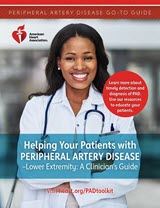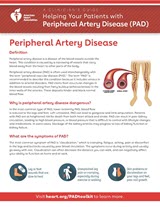PAD Toolkit for Health Care Professionals
Save the legs. Save the feet. Save the heart.
Featured Tools

PAD Go-To-Guide for Health Care Professionals
Our guide is an easy-to-use, interactive tool that empowers doctors and nurses to engage patients diagnosed with peripheral artery disease. Access resources and the AHA’s latest patient engagement tools to deliver effective patient education.
PAD Webinars (non-CME)
Managing PAD
View the three-part PAD Webinar Series created by the American Heart Association through an educational fund from Janssen. Pad experts discuss assessing, treating and managing peripheral artery disease in diverse communities. Topics include: the clinical assessment of PAD on the primary care spectrum with Dr. Eileen Walsh; treating PAD in underserved communities with Dr. Antonio Gutierrez and Dr. Amy West Pollack; and exercise therapy for PAD patients with Dr. Diane Treat-Jacobson.
Visit the three-part PAD Webinar Series
Recognizing the Signs and Symptoms of PAD
Amy Pollak, M.D., Mayo Clinic (cardiovascular medicine) speaks about detecting and diagnosing PAD, a disease that affects more than 113 million adults worldwide and over 8.5 million adults over age 40 in the United States. While it’s a serious risk factor for coronary artery disease and cerebrovascular disease, PAD remains a largely overlooked condition.
Peripheral Artery Disease Roundtable Report
In December 2018, the American Heart Association and National Heart, Lung, and Blood Institute jointly convened multidisciplinary health care professionals representing over 40 health organizations to a PAD Roundtable. They identified strategies to improve public awareness of PAD prevention and increase awareness of PAD recognition and management among patients and health care professionals. The outcome of the session is the PAD Roundtable Report.
etc talk™
Part of a series of etc talks created by the Anticoagulation Forum, Dr. Jeffrey Weitz gets to the heart of issues surrounding vascular health in under 10 minutes, with highlights from a recent study on combination therapy in vascular protection. Discover how treatment can benefit patients by reducing cardiovascular events while balancing risk of increased bleeding by exploring the COMPASS trial with Dr. Weitz.
View this series of etc talks(link opens in new window)
Whiteboard Video
In less than three minutes, Dr. Jeffrey Weitz will provide a simple graphic overview of how blood clots form and how to minimize risk factors associated with blood clots that can lead to heart attack, stroke and peripheral artery disease.
View the Whiteboard Video(link opens in new window)
Ticagrelor Webinar
Data suggests that patients with symptomatic peripheral artery disease taking clopidogrel have a lower risk of cardiovascular events than those receiving aspirin. How does clopidogrel compare with ticagrelor in reducing major bleeding among these patients? Dr. Will Hiatt, lead author from the University of Colorado, explains this in depth during the 45-minute webinar.
View the Ticagrelor Webinar(link opens in new window)
Resources for your Patients
PAD Fact Sheet
Help your patients understand the risk factors, signs and symptoms and treatments for PAD.

Talking to Your Patients About PAD
Remind your team that educating your patients about PAD and its treatments should begin with explaining the disease and its risks.
Additional Patient Resources:
- Signs and Symptoms Checklist (PDF) — Accurate PAD diagnoses rely on a thorough patient history and physical exam. Use this checklist when asking your patients about their risk factors and symptoms.
- Watch, Learn, Live — Help your patients understand PAD by viewing this illustration.
- Answers by Heart Fact Sheets — These downloadable patient information sheets can help your patients understand their condition and needed lifestyle changes and treatments.
- How Can Physical Activity Become a Way of Life (PDF) — Educate your patients on the importance of being physically active.
- Support Network — Connect your patients with peer-to-peer support by recommending our online Support Network.
Video: Top 3 Reasons to Take Your Socks Off





